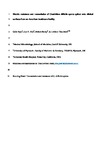Biocide Resistance and Transmission of Clostridium difficile Spores Spiked onto Clinical Surfaces from an American Health Care Facility
| dc.contributor.author | Dyer, C | |
| dc.contributor.author | Hutt, LP | |
| dc.contributor.author | Burky, R | |
| dc.contributor.author | Joshi, LT | |
| dc.date.accessioned | 2019-07-12T19:23:45Z | |
| dc.date.available | 2019-07-12T19:23:45Z | |
| dc.date.issued | 2019-07-12 | |
| dc.identifier.issn | 0099-2240 | |
| dc.identifier.issn | 1098-5336 | |
| dc.identifier.other | e01090-19 | |
| dc.identifier.uri | http://hdl.handle.net/10026.1/14639 | |
| dc.description.abstract |
<jats:p><jats:italic>Clostridium difficile</jats:italic> is the primary cause of antibiotic-associated diarrhea globally. In unfavourable environments the organism produces highly resistant spores which can survive microbicidal insult. Our previous research determined the ability of <jats:italic>C. difficile</jats:italic> spores to adhere to clinical surfaces; finding that spores had marked different hydrophobic properties and adherence ability. Investigation into the effect of the microbicide sodium dichloroisocyanurate on <jats:italic>C. difficile</jats:italic> spore transmission revealed that sub-lethal concentrations increased spore adherence without reducing viability. The present study examined the ability of spores to transmit across clinical surfaces and their response to an in-use disinfection concentration of 1,000-ppm of chlorine-releasing agent sodium dichloroisocyanurate. In an effort to understand if these surfaces contribute to nosocomial spore transmission, surgical isolation gowns, hospital-grade stainless steel and floor vinyl were spiked with 1 × 10<jats:sup>6</jats:sup> spores/ml of two types of <jats:italic>C. difficile</jats:italic> spore preparations: crude spores and purified spores. The hydrophobicity of each spore type versus clinical surface was examined via plate transfer assay and scanning electron microscopy. The experiment was repeated and spiked clinical surfaces were exposed to 1,000-ppm sodium dichloroisocyanurate at the recommended 10-min contact time. Results revealed that the hydrophobicity and structure of clinical surfaces can influence spore transmission and that outer spore surface structures may play a part in spore adhesion. Spores remained viable on clinical surfaces after microbicide exposure at the recommended disinfection concentration demonstrating ineffectual sporicidal action. This study showed that <jats:italic>C. difficile</jats:italic> spores can transmit and survive between varying clinical surfaces despite appropriate use of microbicides.</jats:p> <jats:p><jats:bold>IMPORTANCE</jats:bold> <jats:italic>Clostridium difficile</jats:italic> is a healthcare-acquired organism and the causative agent of antibiotic-associated diarrhoea. Its spores are implicated in faecal to oral transmission from contaminated surfaces in the healthcare environment due to their adherent nature. Contaminated surfaces are cleaned using high-strength chemicals to remove and kill the spores; however, despite appropriate infection control measures, there is still high incidence of <jats:italic>C. difficile</jats:italic> infection in patients in the US. Our research examined the effect of a high-strength biocide on spores of <jats:italic>C. difficile</jats:italic> which had been spiked onto a range of clinically relevant surfaces including isolation gowns, stainless steel and floor vinyl. This study found that <jats:italic>C. difficile</jats:italic> spores were able to survive exposure to appropriate concentrations of biocide; highlighting the need to examine the effectiveness of infection control measures to prevent spore transmission, and consideration of the prevalence of biocide resistance when decontaminating healthcare surfaces.</jats:p> | |
| dc.format.extent | e01090-e01019 | |
| dc.format.medium | Electronic-Print | |
| dc.language | en | |
| dc.language.iso | en | |
| dc.publisher | American Society for Microbiology | |
| dc.subject | Clostridium difficile | |
| dc.subject | biocide | |
| dc.subject | public health | |
| dc.subject | spores | |
| dc.subject | surfaces | |
| dc.subject | survival | |
| dc.subject | transmission | |
| dc.title | Biocide Resistance and Transmission of Clostridium difficile Spores Spiked onto Clinical Surfaces from an American Health Care Facility | |
| dc.type | journal-article | |
| dc.type | Article | |
| plymouth.author-url | https://www.ncbi.nlm.nih.gov/pubmed/31300397 | |
| plymouth.issue | 17 | |
| plymouth.volume | 85 | |
| plymouth.publication-status | Published | |
| plymouth.journal | Applied and Environmental Microbiology | |
| dc.identifier.doi | 10.1128/aem.01090-19 | |
| plymouth.organisational-group | /Plymouth | |
| plymouth.organisational-group | /Plymouth/Faculty of Health | |
| plymouth.organisational-group | /Plymouth/Faculty of Health/School of Biomedical Sciences | |
| plymouth.organisational-group | /Plymouth/REF 2021 Researchers by UoA | |
| plymouth.organisational-group | /Plymouth/REF 2021 Researchers by UoA/UoA01 Clinical Medicine | |
| plymouth.organisational-group | /Plymouth/Users by role | |
| plymouth.organisational-group | /Plymouth/Users by role/Academics | |
| dc.publisher.place | United States | |
| dcterms.dateAccepted | 2019-06-20 | |
| dc.rights.embargodate | 2020-1-12 | |
| dc.identifier.eissn | 1098-5336 | |
| dc.rights.embargoperiod | Not known | |
| rioxxterms.versionofrecord | 10.1128/aem.01090-19 | |
| rioxxterms.licenseref.uri | http://www.rioxx.net/licenses/all-rights-reserved | |
| rioxxterms.licenseref.startdate | 2019-07-12 | |
| rioxxterms.type | Journal Article/Review |


